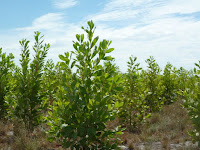A multi-disciplinary group of Corpoverde (“Green Orinoco”) experts have developed a special forestry fertilizer for use in plantations in the eastern plains or llanos orientales of Colombia. This special forestry fertilizer mix meets the needs of tropical trees planted in infertile ground and in high rainfall conditions. These conditions definitely apply to many of the areas in which Amazonia Reforestation and CO2 Tropical Trees do their planting. Tropical trees are the ultimate recyclers, but to achieve rapid growth and best results it is important to provide the right mix of minerals and elements during the early stages of the planted trees’ growth. Proper fertilization in the early stages of an afforestation and reforestation project can have an important impact on soil quality later on.
Tropical soils are often infertile because of the heavy rainfall that occurs for 8 months of the year, leaching most nutrients out of the soil. That is why subsistence farmers have such poor results after indiscriminately cutting down rain forest. One subsistence crop later the soil is depleted and they are cutting down another area of rain forest in hopes of better conditions. This is, of course, the definition of insanity, doing the same thing over and over again anticipating a different result every time. Unfortunately, subsistence use of organic fertilizers like biochar by campesinos is often misunderstood, making conditions worse, because they fail to deactivate the biochar before use. Biochar may also be the cause of further deforestation, as subsistence farmers cut down trees to produce the charcoal component of their homemade fertilizer when they plant those subsistence crops.
An ideal tropical tree fertilizer mix consists of the following: 5% nitrogen (N), 17% phosphorus (P2O5), 2.5% potassium (K2O), 16% calcium (CaO), 12% magnesium (MgO), 22% silicon (SiO2), 0.5% zinc, 0.7% boron (B), 2% Sulphur (S), 0.005% cobalt Co) and 0.01% molybdenum (Mo). When applying this special forestry mix to tropical soils, the following quantities should be used on a minimum to maximum basis per hectare (per 2.47 acres): 50 - 250 kg of nitrogen (N), 25 - 100 kg of phosphorus (P), 40 – 160 kg of potassium (K), 140 – 200 kg of calcium (Ca), 10 – 15 kg of magnesium (Mg), 20 – 30 kg of sulphur (S), 5 to 10 kg of zinc (Z), 1 to 4 kg of boron (B), 2 – 3 kg of iron (Fe), 2 to 3 kg of manganese (Mn), 2 to 3 kg of copper (Cu) and 0.1 to 0.3 kg of molybdenum (Mo). The above translates into approximately 140 grams of fertilizer applied at a depth of 5 to 8 cm around each young tree, just before or just after the rainy season. Amazonia Reforestation uses this mix in the areas that are most devastated and in need of reclamation.




I Don't understand what you mean by "fail to deactivate the biochar"
ReplyDeleteHere in the north we "charge" or inoculate our raw biochar to avoid N starvation in the first season of application.
Erich
That is what I meant. A lot of tropical biochar users find out that the biochar left in an unprocessed state sucks in all the nutrients and nitrogen. With biochar it is important to charge fresh charcoal first so that it can function as a biotope. Uncharged charcoal causes a depletion of available nutrients when first put into the soil - until its pores fill up with nutrients. This is avoided by soaking the charcoal for 2 to 4 weeks in a liquid nutrient made of urine or animal manures or compost tea. Mixing char to the mix provides habitat and support for the microorganisms. The result is a winning combination, producing a superior fertilizer for organic growing. By deactivate I meant charge it so it doesn't suck in the goodies.
ReplyDelete